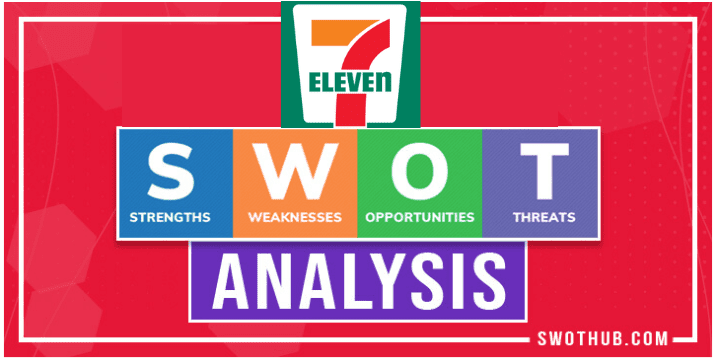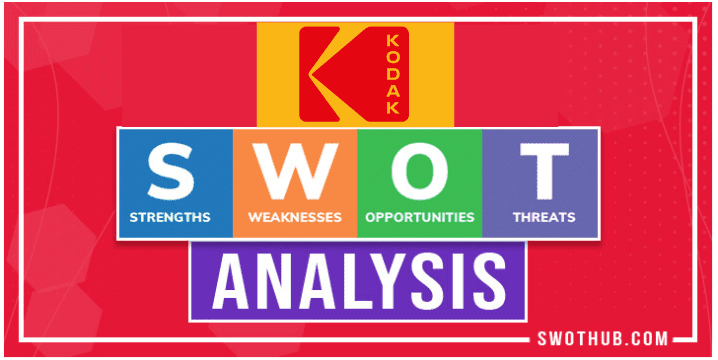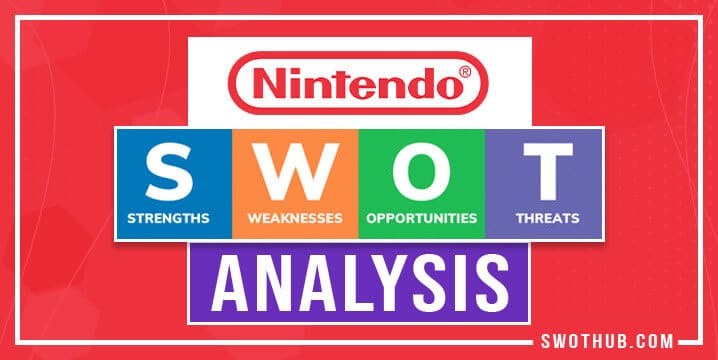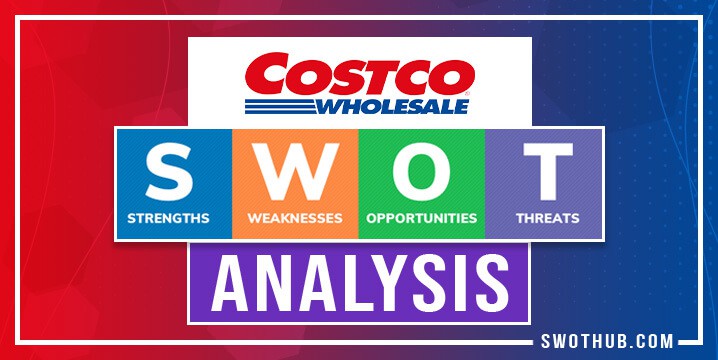In a 7-Eleven SWOT analysis, we look at how the largest convenience store retailer in the world has dominated its competitors. With over 83,000 stores across 19 countries, this iconic global brand is easily recognizable as a convenient one-stop shop. As a pioneer of many well-known drinks, food items, and convenience items let’s take a look at 7-Eleven’s strengths, weaknesses, opportunities, and threats against its competitors.
Table of Contents
7-Eleven History
The American convenience store chain 7-Eleven, Inc. was established in Dallas, Texas, in 1927. Initially known as Southland Ice Company, the business ran an icehouse where customers could purchase ice blocks to keep their food cold. However, Joe C. Thompson and John Jefferson Green, the company’s founders, realized in 1927 that they could sell essential groceries like milk, bread, and eggs from the same location as their ice business.
They started out by opening small stores in various Dallas neighborhoods, and by 1946, they had changed the name of the business to 7-Eleven in honor of the new store hours of 7 a.m. to 11 p.m.
In a 7-Eleven SWOT analysis, the chain opened its first overseas location in Canada in 1969. Over the ensuing decades, the company kept growing both domestically and abroad. The company was purchased by the Japanese retail conglomerate Ito-Yokado in 1971, which aided in funding the chain’s further growth and modernization. Currently, 7-Eleven is the largest convenience store chain in the world, with more than 71,000 locations across 17 nations.
The iconic Slurpee frozen drink and the Big Gulp oversized sodas are just two of the creative marketing and merchandising tactics for which 7-Eleven has become known throughout its history. The business also pioneered the introduction of self-serve hot food and beverage stations, digital ordering platforms, and mobile payment options in the convenience retailing industry.
7-Eleven stores are located within a two-mile radius of 52% of the United States population.
Millions of customers all over the world continue to frequent 7-Eleven in search of snacks, beverages, and everyday household necessities, despite the chain’s increased competition from other convenience store chains and online retailers. 7‑Eleven, Inc. is wholly owned by Seven & i Holdings Co. Ltd.
What are the 7-Eleven Brands?
7-Eleven, Inc. operates several brands other than just the 7-Eleven convenience stores.
The family of establishments includes:
- Stripes
- Speedway
- Laredo Taco Company
- Raise the Roost Chicken and Biscuits
7-Eleven SWOT Analysis At-A-Glance
| Company | 7-Eleven |
| Parent Company | Seven & i Holdings Co. Ltd. |
| Industry | Convenience Store |
| Founder | Joe C. Thompson |
| Year founded | 1927 |
| CEO | Joseph DePinto |
| Headquarters | Irving, Texas |
| Number of employees | 135,332 (2021) |
| Revenue (FY 2022) | US $87.60 Billion (2022) |
…
7-Eleven SWOT Analysis:
A SWOT analysis is a framework used to assess a company’s competitive situation and to create strategic planning. By taking 7-Eleven’s strengths, and weaknesses of 7-Eleven’s threats of 7-Eleven as well as opportunities of 7-Eleven into account, we may better gain in-depth knowledge about the 7-Eleven company. In this article, we’ll be taking a look at 7-Eleven’s SWOT framework to better understand its competitive position and potential for future growth. See how 7-Eleven competitors fare against them and learn about 7-Eleven’s Strengths, weaknesses, opportunities, and 7-Eleven threats.
7-Eleven SWOT Analysis Strengths:
The areas where a company excels above average or in a manner that distinguishes it from its rivals are its strengths. 7-Eleven strengths are outlined in this 7-Eleven SWOT analysis. In a SWOT analysis of 7-Eleven, some of its strengths compared to competitors include:
What are the strengths of 7-Eleven?
Strong brand recognition: The name and logo of 7-Eleven are instantly recognizable and are linked to accessibility, affordability, and convenience.
Wide range of products: 7-Eleven offers a wide range of products, including snacks, drinks, grocery items, and even hot food and beverage options. In a 7-Eleven SWOT analysis several of the most popular convenience were first created by 7-Eleven, these products include:
- Coffee in “to-go” cups
- Stores are open 24 hours and 7 days a week “24/7”
- Self-serve soda fountain drinks
- Slurpee frozen treat
- Big Gulp drinks
Convenience and accessibility: Customers can easily access 7-Eleven thanks to its more than 71,000 locations across 17 countries, many of which are open around the clock. Customers who need to make quick purchases or access necessities outside of regular business hours now have a convenient option.
Technological innovation: 7-Eleven has been at the forefront of technological innovation in the convenience store industry, introducing new digital ordering and payment options, self-serve food and beverage stations, and other technological advancements that enhance the customer experience.
Strong franchise network: 7-Eleven pioneered the franchise model. Each store primarily operates as a franchise, which enables the business to grow quickly and profitably. The company works closely with its franchisees to ensure that they adhere to the company’s standards for quality and customer service. The company offers training and support to its franchisees.
Overall, 7-Eleven’s strengths are rooted in its ability to provide customers with a convenient and accessible shopping experience, a wide range of products, and innovative technology, while also maintaining a strong brand identity and franchise system.
7-Eleven SWOT Analysis Weaknesses:
Weaknesses of a company are those that limit its potential, make it less competitive, and prevent it from achieving its goals. In this section of the 7-Eleven SWOT analysis, we’ll look at 7-Eleven weaknesses. Some of their weaknesses compared to competitors include:
Limited product offerings: The small size of its stores may limit 7-Eleven’s ability to offer a wide range of products, even though it is well known for its convenience goods like snacks and drinks. In recent years 7-Eleven has started a new type of store called the 7-Eleven Evolution store which features unique food, beverages, etc.… that are restaurant quality.
Dependence on franchisees: In a 7-Eleven SWOT analysis, franchisees own and run a sizable portion of 7-Eleven’s retail locations. Franchisees might not always adhere to the same standards as corporate-owned stores, which can cause problems with consistency and quality control.
Competition: 7-Eleven faces competition from a variety of retailers, including other convenience stores, grocery stores, and online retailers.
Geographic concentration: While 7-Eleven has a large presence in some countries, such as Japan, it may be less well-known or less prevalent in other markets. This can limit its growth potential in certain regions.
Dependence on gasoline sales: The profitability of 7-Eleven may be significantly impacted by the sale of gasoline in some markets. Gas price swings can have a big impact on the business’s bottom line in this market, which can be quite volatile.
Negative reputation: 7-Eleven has faced criticism in the past for labor practices and treatment of franchisees. This negative reputation could impact its ability to attract customers and potential franchisees.
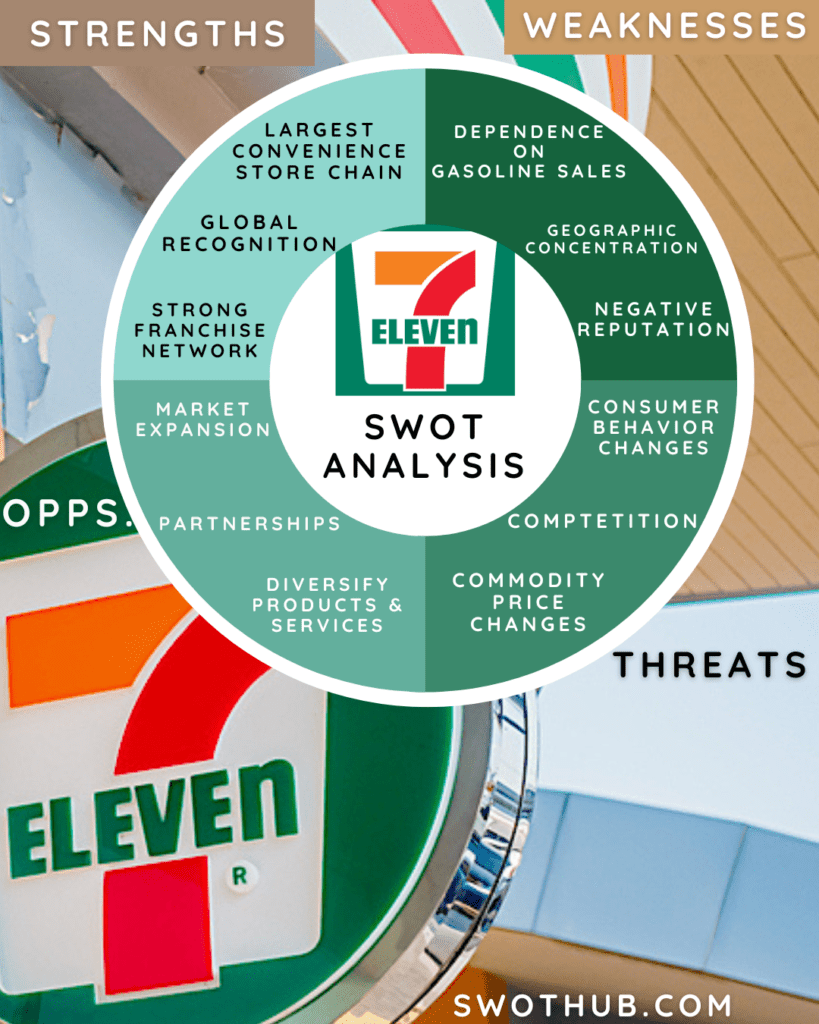
7-11 SWOT Analysis Opportunities:
The following portion of the 7-Eleven SWOT analysis will examine some of 7-Eleven’s opportunities compared to competitors include:
Expansion into new markets: 7-Eleven can expand its footprint into new markets, both domestically and internationally, where it currently has little or no presence.
Diversification of products and services: In a 7-Eleven SWOT Analysis, they could expand its offerings beyond the typical convenience store items, such as introducing healthy food options, and fresh produce, or adding services like mobile payments or mobile ordering.
E-commerce and delivery: 7-Eleven could expand its online ordering and delivery options to meet the growing demand for e-commerce.
Partnerships and collaborations: The company could collaborate with other retailers or companies to offer new products or services. For example, 7-Eleven has partnered with delivery services like Postmates and Door Dash to expand its delivery options.
Sustainability: There is a growing demand for sustainable and eco-friendly products and practices, and 7-Eleven could capitalize on this trend by offering more sustainable products and reducing its environmental impact.
Franchise growth: 7-Eleven could focus on growing its franchise network and improving support for franchisees to increase revenue and profitability.
7-Eleven SWOT Analysis Threats:
Threats pose a risk to every company’s stability and profitability. In this 7-Eleven SWOT analysis, we will address some of the threats that are important to examine.
In a SWOT analysis of 7-Eleven, some of its largest threats compared to competitors include:
What are the threats of a convenience store?
Intense competition: The convenience store industry is highly competitive, with many established players and new entrants constantly vying for market share. With its largest competitors being Wawa and Circle K brands.
Changes in consumer behavior: Changes in consumer behavior, such as increased online shopping, a shift towards healthier food options, or decreased commuting, could impact 7-Eleven’s sales.
Fluctuations in commodity prices: 7-Eleven’s profitability can be significantly impacted by fluctuations in commodity prices, particularly in the gasoline market.
Regulatory changes: Changes in regulations or laws, such as increases in the minimum wage or new food safety regulations, could increase costs for 7-Eleven.
Negative publicity: Customers or the media may criticize 7-Eleven, particularly in relation to its labor policies, how it treats its franchisees, or how it affects the environment.
These threats are true of all convenience stores, including 7-Eleven.
7-Eleven Competitors:
In a SWOT analysis of 7-Eleven its competitors would fall under the “threats” category. Here are some of the 7-Eleven main competitors in the convenience store industry. Many people ask:
Who are 7-Eleven’s Biggest Competitors?
- Other convenience stores: Competitors in this category include Circle K, Wawa, Sheetz, and Speedway. (Speedway was acquired by Seven and I Holdings in 2021.)
- Gas station chains: Many gas stations also offer convenience items, such as snacks and drinks, and are therefore indirect competitors to 7-Eleven. Examples include Shell, BP, and Exxon.
- Grocery stores: In a 7-Eleven SWOT analysis, some grocery stores have expanded their offerings to include convenience items, such as pre-packaged snacks and beverages. Examples include Walmart, Kroger, and Target.
7-Eleven SWOT Analysis – Conclusion and Recommendations:
7-Eleven needs to focus on a number of key strategies to remain competitive in the convenience store industry.
Based on the 7-11 SWOT analysis, here are some recommendations that 7-Eleven could consider increasing growth in the future:
- Diversify product offerings: 7-Eleven could expand its product offerings to include healthier food options, fresh produce, and other items that are in line with current consumer trends.
- Emphasize e-commerce and delivery: Given the growing demand for online ordering and delivery, 7-Eleven should continue to expand its e-commerce capabilities and delivery options.
- Focus on sustainability: As consumers become more environmentally conscious, 7-Eleven should prioritize sustainability initiatives and reduce its environmental impact. Parent company Seven & i do have a few environmental initiatives they have implemented as well.
- Innovate and invest in technology: 7-Eleven should continue to invest in technology and innovation to improve the customer experience, such as implementing self-checkout or introducing loyalty programs.
- Strengthen franchise support: In a 7-11 SWOT analysis they could focus on strengthening its support for franchisees to improve consistency and quality control, and ultimately increase revenue and profitability.
- Continue to expand internationally: With its success in certain international markets, 7-Eleven should consider expanding further into new markets to capitalize on growth opportunities.
- Foster partnerships and collaborations: The company could collaborate with other retailers or companies to offer new products or services, or partner with delivery services to expand its delivery options.
FAQs for 7-Eleven:
What kind of business is 7-Eleven?
7-Eleven is a convenience store chain that operates globally. It offers a wide range of products, including snacks, beverages, prepared foods, and everyday essentials. The stores are known for their extended operating hours, often staying open 24/7, providing customers with easy access to items at any time of day.
How much does a 7-Eleven owner make a month?
The income of a 7-Eleven franchise owner can vary significantly based on factors such as location, store size, local economy, and the owner’s management skills. On average, a 7-Eleven store owner can potentially earn a net profit ranging from $50,000 to $150,000 per year, which translates to an approximate monthly income of $4,000 to $12,500. However, it’s important to note that these figures can differ widely and are not guaranteed.
How is 7-Eleven so successful?
Strategic locations, 24/7 accessibility, various items, a successful franchise model, adaptive innovation, great branding, regional tactics, and community involvement make 7-Eleven successful. These elements make shopping convenient and enticing, boosting its global success.
These suggestions could help 7-Eleven strengthen its areas of weakness, seize opportunities, counter threats, and ultimately grow more quickly in the future. While 7-Eleven is considered to be the largest convenience store network in the world, it still has several opportunities to continue to grow and thrive against its competitors.

